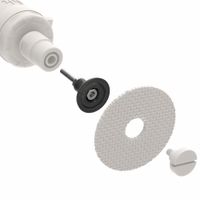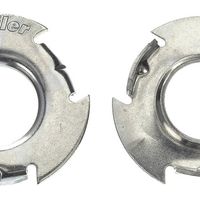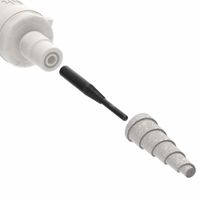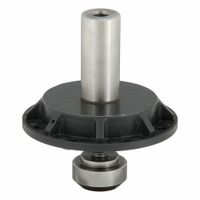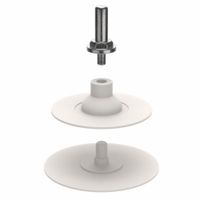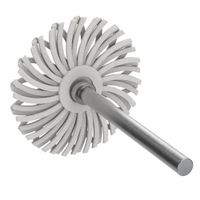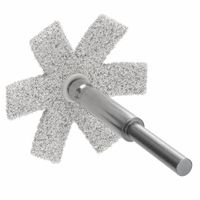Call +(254) 703 030 000 / 751 483 999 / 721 704 777
- Home
- Abrasives
- Abrasive Accessories
- Mandrels Arbors Adapters For Abrasives
.....Read More
Frequently Asked Questions
What is the difference between a mandrel and an arbor?
A mandrel and an arbor are both tools used to support or hold workpieces, but they serve different purposes and are used in distinct contexts.
A mandrel is a cylindrical tool inserted into a workpiece to support it during machining or to shape it. It is commonly used in metalworking, woodworking, and jewelry making. Mandrels are often used in lathes to hold hollow workpieces, such as tubes or rings, ensuring they remain stable and concentric during operations like turning, grinding, or polishing. They can be expandable or solid, depending on the application, and are designed to fit snugly inside the workpiece.
An arbor, on the other hand, is a shaft or spindle used to mount tools or workpieces, typically in a machine like a milling machine or a drill press. Arbors are used to hold cutting tools, such as saw blades, milling cutters, or grinding wheels, allowing them to rotate and perform machining operations. They are designed to fit into the machine's spindle and often have a tapered end to ensure a secure fit. Arbors can also be used to hold workpieces, but their primary function is to support and drive cutting tools.
In summary, the main difference lies in their applications: mandrels are primarily used to support and shape workpieces, while arbors are used to mount and drive cutting tools or workpieces in machining operations.
How do I choose the right mandrel for my tool?
To choose the right mandrel for your tool, consider the following factors:
1. **Tool Compatibility**: Ensure the mandrel is compatible with the tool you are using. Check the manufacturer's specifications for recommended mandrel types and sizes.
2. **Material Type**: Select a mandrel made from a material that suits the application. Common materials include steel, carbide, and aluminum. Steel is durable, carbide offers high wear resistance, and aluminum is lightweight.
3. **Size and Fit**: The mandrel must fit the tool and the workpiece securely. Measure the diameter and length required for your specific application. A proper fit ensures stability and precision during operation.
4. **Application Requirements**: Consider the specific requirements of your application, such as the type of workpiece material, the desired finish, and the level of precision needed. Different mandrels are designed for specific tasks, such as sanding, polishing, or drilling.
5. **Load Capacity**: Ensure the mandrel can handle the load and speed of your tool. Check the maximum RPM and torque ratings to prevent tool failure or damage.
6. **Ease of Use**: Look for mandrels that are easy to install and remove. Quick-change mandrels can save time and increase efficiency in high-volume operations.
7. **Cost and Availability**: Consider your budget and the availability of the mandrel. While high-quality mandrels may cost more, they often provide better performance and longevity.
8. **Brand and Quality**: Choose mandrels from reputable brands known for quality and reliability. Read reviews and seek recommendations to ensure you are investing in a durable product.
By evaluating these factors, you can select the right mandrel that meets your tool's requirements and enhances your project's efficiency and quality.
What are the common sizes of arbors for abrasive wheels?
Common sizes of arbors for abrasive wheels typically include diameters of 1/4 inch, 1/2 inch, 5/8 inch, 3/4 inch, 1 inch, and 1-1/4 inches. These sizes are designed to fit various types of grinding machines and tools, ensuring compatibility and secure attachment. The choice of arbor size depends on the specific application, the type of abrasive wheel being used, and the equipment's design.
How do adapters work with mandrels and arbors?
Adapters, mandrels, and arbors are essential components in machining and tool setups, facilitating the connection and operation of various tools and machines.
Adapters serve as intermediaries, allowing tools with different sizes or types of connections to be used together. They modify the interface between the tool and the machine, ensuring compatibility and secure attachment. For instance, an adapter might convert a tool with a smaller shank to fit a larger spindle.
Mandrels are cylindrical tools used to support workpieces during machining. They are inserted into the workpiece's bore, providing stability and alignment. Mandrels ensure that the workpiece rotates accurately around its axis, which is crucial for operations like turning or grinding. They come in various types, such as expanding mandrels, which can adjust to fit different bore sizes.
Arbors are shafts or spindles used to mount tools like saw blades, grinding wheels, or milling cutters onto a machine. They provide the necessary support and alignment for the tool to function correctly. Arbors often have a tapered end to fit into the machine's spindle and a threaded or keyed section to secure the tool.
Adapters work with mandrels and arbors by bridging compatibility gaps. For example, if a mandrel or arbor has a different taper or thread size than the machine spindle, an adapter can be used to ensure a proper fit. This adaptability is crucial in diverse machining environments where tools and machines may not inherently match.
In summary, adapters enhance the versatility of mandrels and arbors by enabling them to connect with various machines and tools, ensuring efficient and precise machining operations.
Can I use any mandrel with any rotary tool?
No, you cannot use any mandrel with any rotary tool. Compatibility between mandrels and rotary tools depends on several factors, including the size of the mandrel's shank, the type of rotary tool, and the specific application or accessory being used.
1. **Shank Size**: The shank size of the mandrel must match the collet or chuck size of the rotary tool. Common shank sizes are 1/8 inch (3.175 mm) and 1/4 inch (6.35 mm). Using a mismatched shank size can lead to improper fitting, reduced performance, or even damage to the tool or accessory.
2. **Tool Type**: Different rotary tools are designed for specific applications and may have limitations on the types of accessories they can accommodate. For example, a high-speed rotary tool may not be suitable for heavy-duty applications that require larger mandrels.
3. **Accessory Compatibility**: Mandrels are designed to hold specific types of accessories, such as cutting wheels, sanding discs, or polishing pads. Ensure that the mandrel is compatible with the accessory you intend to use. Some mandrels are designed for quick-change systems, while others require manual tightening.
4. **Tool Specifications**: Always refer to the manufacturer's specifications and guidelines for both the rotary tool and the mandrel. This ensures that you are using compatible components and operating the tool safely.
5. **Safety Considerations**: Using an incompatible mandrel can lead to safety hazards, such as the accessory detaching during operation, which can cause injury or damage.
In summary, always verify the compatibility of the mandrel with your rotary tool by checking the shank size, tool type, accessory compatibility, and manufacturer guidelines to ensure safe and effective operation.
What materials are mandrels and arbors typically made from?
Mandrels and arbors are typically made from materials that offer a combination of strength, durability, and resistance to wear and deformation. Common materials include:
1. **Steel**: Often used for its strength and durability, steel is a popular choice for both mandrels and arbors. High-carbon steel and alloy steel are frequently used due to their hardness and ability to withstand high stress and temperatures.
2. **Hardened Steel**: This is steel that has been heat-treated to increase its hardness and wear resistance. It is particularly useful for applications requiring high precision and longevity.
3. **Stainless Steel**: Known for its corrosion resistance, stainless steel is used in environments where exposure to moisture or chemicals is a concern. It also offers good strength and durability.
4. **Tool Steel**: This is a variety of carbon and alloy steels that are particularly well-suited for making tools. Tool steel is used for its hardness, resistance to abrasion, and ability to hold a sharp edge.
5. **Aluminum**: Lightweight and resistant to corrosion, aluminum is used for mandrels and arbors where weight is a concern, though it is not as strong as steel.
6. **Brass**: Sometimes used for its non-sparking properties and resistance to corrosion, brass is suitable for specific applications, though it is softer than steel.
7. **Carbide**: Tungsten carbide is used for its extreme hardness and wear resistance, especially in high-precision applications or where the mandrel or arbor is subject to significant wear.
8. **Composite Materials**: In some cases, advanced composites may be used for specialized applications requiring unique properties such as reduced weight or enhanced vibration damping.
These materials are chosen based on the specific requirements of the application, including the type of work being performed, the environment, and the desired lifespan of the tool.
How do I properly maintain and store mandrels and arbors?
To properly maintain and store mandrels and arbors, follow these guidelines:
1. **Cleaning**: After each use, clean the mandrels and arbors thoroughly to remove any debris, dust, or residue. Use a soft brush or cloth and, if necessary, a mild solvent to ensure all contaminants are removed.
2. **Inspection**: Regularly inspect the tools for any signs of wear, damage, or corrosion. Check for cracks, bends, or any deformities that could affect performance. Replace any damaged parts immediately to prevent accidents or further damage.
3. **Lubrication**: Apply a light coat of machine oil or a rust-preventive lubricant to the surfaces to protect against rust and corrosion. Ensure that the lubricant is evenly distributed and wipe off any excess to prevent accumulation of dust or debris.
4. **Storage**: Store mandrels and arbors in a dry, cool environment to prevent rust and corrosion. Use a dedicated storage rack or cabinet to keep them organized and protected from physical damage. Ensure they are stored in a way that prevents them from rolling or falling.
5. **Handling**: Handle with care to avoid dropping or striking them against hard surfaces, which can cause damage. Use appropriate tools and techniques when installing or removing them from machinery.
6. **Environment Control**: Maintain a stable environment with controlled humidity and temperature to minimize the risk of corrosion. Use desiccants or dehumidifiers if necessary.
7. **Regular Maintenance**: Schedule regular maintenance checks to ensure they remain in optimal condition. This includes re-lubrication, re-inspection, and cleaning as part of a routine maintenance program.
By following these steps, you can extend the lifespan of your mandrels and arbors, ensuring they remain effective and safe for use.
